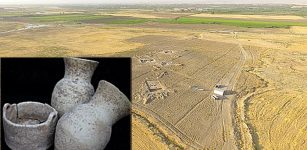Gordian Knot And How Alexander The Great Managed To Outmaneuver The Problem
A. Sutherland - AncientPages.com - The Gordian Knot is a metaphorical expression that means a complicated problem or deadlock when we have an unsolvable problem, which is our "impossible knot."
Alexander the Great slicing the Gordion knot with a sword-stroke. Credit: Public Domain
It began long ago when the Phrygians had no ruler and plunged into a civil war. An ancient prophecy of the oracle was announced at Telmissus (the ancient capital of Lycia).
It said that the new king would be the one who would enter the city in a simple ox-cart.
The first through the city's gates were Gordias, a poor peasant who came to the town with a cart drawn by an ox with his wife. He tied its yoke to a post with a highly sophisticated knot called the Gordian Knot. Gordias was declared king, and his grateful son, Midas, dedicated the ox-cart to the Phrygian god Sabazios (identified with Zeus).
Roman historian Quintus Curtius Rufus later described the knot as a masterwork. It comprised "several knots all so tightly entangled that it was impossible to see how they were fastened."
Gordias founded the city of Gordium, which became the Phrygian capital, and his ox-cart was preserved and remained in the royal palace. According to the oracle's prophecy, a man who untied the knot would receive power over Asia Minor or all of Asia.
In the 4th century BC, Alexander the Great reached Phrygia and Gordium, allegedly Midas's capital. After taking the city of Gordium, Alexander was shown the chariot of Gordias, founder of the old Phrygian monarchy, and was told about the prophecy.
Alexander wanted to untie the knot, but he had no idea how to do it, so he drew his sword and sliced it in half with a single stroke, or as another version says, he loosed the knot by pulling the linchpin from the yoke.
Aristobulus, an early historian, architect, and military engineer, as well as a close friend of Alexander) later claimed that untying the knot was easy for Alexander; he removed what they call the pole-pin, with which the yoke-knot was held together, and then drew back the yoke.
We will never know what really happened in the palace in Gordium and whether Alexander managed to untie the complex knot.
Norman F. Cantor, in his book "Alexander the Great Journey to the End of the Earth" writes:
"Shortly after one of Alexander's first victories, the Battle of Granicus, he learned that a few miles away, a certain King Gordias had left as a legacy a very difficult knot to untie. It was said (probably by Alexander's propagandists) that whoever untied the knot would conquer all of Asia. Sources disagree about what happened.
Some say that Alexander cleverly untied the knot, others that he simply unsheathed his sword and cut it. But one way or another, he untied or "cut the Gordian knot."
Fox relates the tale this way:" On the day before leaving Gordium, he went up to the acropolis meaning to try the chariot which he had saved for his farewell; friends gathered round to watch him, but hard though he pulled, the knot round the yoke remained stubbornly tight. When no end could be found, Alexander began to lose patience, for failure would not go down well with his men. Drawing his sword, he slashed the knot in half, producing the necessary end and correctly claiming that the knot was loosed, if not untied. The aged Aristobulus (one of Alexander's early historians)… later claimed that Alexander had pulled a pin out of the chariot link and drawn the yoke out sideways through the knot, but the sword cut has the weight of authority behind it and is preferable to an eighty-year-old historian's apology; either way, Alexander outmaneuvered, rather than unraveled, his problem.
He also managed to arouse an interest in what he had done."
"There were thunderclaps and flashes of lightning that very night," conveniently signifying that Zeus approved, so Alexander offered sacrifice to the "gods who had sent the signs and ratified his loosing of the knot..." (Robin Lane Fox, Alexander the Great)
Tough, resolute, fearless. Alexander was a born warrior and a ruler of passionate ambition who understood the intense adventure of conquest and of the unknown. When he died in 323 B.C.E. at age thirty-two, his vast empire comprised more than two million square miles, spanning from Greece to India. His achievements were unparalleled—he had excelled as a leader to his men, founded eighteen new cities, and stamped the face of Greek culture on the ancient East. The myth he created is as potent today as it was in the ancient world. Robin Lane Fox's superb account searches through the mass of conflicting evidence and legend to focus on Alexander as a man of his own time. Combining historical scholarship and acute psychological insight, it brings this colossal figure vividly to life.." Read more
Alexander later went on to conquer Asia as far as the Indus and the regions of the Oxus, a major river in Central Asia. The prophecy was fulfilled.
Written by – A. Sutherland AncientPages.com Staff Writer
First version of this article was published on July 20, 2020
Copyright © AncientPages.com All rights reserved. This material may not be published, broadcast, rewritten or redistributed in whole or part without the express written permission of AncientPages.com
More From Ancient Pages
-
 Viking Burial Rituals: High Ancient Funeral Pyre Reflected High Social Status
Ancient Traditions And Customs | Mar 13, 2017
Viking Burial Rituals: High Ancient Funeral Pyre Reflected High Social Status
Ancient Traditions And Customs | Mar 13, 2017 -
 Secrets Of Viking Crystal Sunstones Revealed By Modern Science
Archaeology | Apr 5, 2018
Secrets Of Viking Crystal Sunstones Revealed By Modern Science
Archaeology | Apr 5, 2018 -
 Biblical City Of Tarsus: Excavations Reveal Its Secrets From Paul the Apostle’s Times
Archaeology | Jan 4, 2016
Biblical City Of Tarsus: Excavations Reveal Its Secrets From Paul the Apostle’s Times
Archaeology | Jan 4, 2016 -
 Darabgerd: One Of The Oldest Cities Dated To Achaemenid Era
Featured Stories | Jan 28, 2021
Darabgerd: One Of The Oldest Cities Dated To Achaemenid Era
Featured Stories | Jan 28, 2021 -
 New Study Challenges Theories Of Earlier Human Arrival In Americas – Archaeological Evidence Has Been Misinterpreted – Scientists Say
Archaeology | Apr 21, 2022
New Study Challenges Theories Of Earlier Human Arrival In Americas – Archaeological Evidence Has Been Misinterpreted – Scientists Say
Archaeology | Apr 21, 2022 -
 On this day in history: Li Shimin becomes Emperor Taizong of Tang, China – Sep 4, 626
News | Sep 4, 2015
On this day in history: Li Shimin becomes Emperor Taizong of Tang, China – Sep 4, 626
News | Sep 4, 2015 -
 Mystery Of The Copper Age ‘Ivory Lady’ Solved
Archaeology | Jul 6, 2023
Mystery Of The Copper Age ‘Ivory Lady’ Solved
Archaeology | Jul 6, 2023 -
 16 Meters Long Ancient Papyrus With Spells From The Book Of The Dead Found In Saqqara
Archaeology | Jan 19, 2023
16 Meters Long Ancient Papyrus With Spells From The Book Of The Dead Found In Saqqara
Archaeology | Jan 19, 2023 -
 Mesopotamian People Liked To Drink Beer Using Variety Of Drinking Vessels
Archaeology | Jun 28, 2018
Mesopotamian People Liked To Drink Beer Using Variety Of Drinking Vessels
Archaeology | Jun 28, 2018 -
 Mystery Of Human Evolution – What Can Ancient Genes Tell Us About Who We Are?
Archaeology | Jun 2, 2022
Mystery Of Human Evolution – What Can Ancient Genes Tell Us About Who We Are?
Archaeology | Jun 2, 2022 -
 Hidden 15th-Century Text On Medieval Manuscripts – Discovered By Students
News | Nov 23, 2020
Hidden 15th-Century Text On Medieval Manuscripts – Discovered By Students
News | Nov 23, 2020 -
 New Giant Geoglyph Of Orca With Mysterious Symbols And A ‘Trophy Head’ Found In Nazca Lines
Archaeology | Nov 18, 2017
New Giant Geoglyph Of Orca With Mysterious Symbols And A ‘Trophy Head’ Found In Nazca Lines
Archaeology | Nov 18, 2017 -
 Cache Of 13,000 Ostraca Unearthed In Upper Egypt’s Sohag
Archaeology | Dec 21, 2021
Cache Of 13,000 Ostraca Unearthed In Upper Egypt’s Sohag
Archaeology | Dec 21, 2021 -
 Ancient Knowledge About The Cycle Of Renewal And The Next Human Phase – Gods And Guardians Of The Earth
Ancient Mysteries | Feb 16, 2020
Ancient Knowledge About The Cycle Of Renewal And The Next Human Phase – Gods And Guardians Of The Earth
Ancient Mysteries | Feb 16, 2020 -
 Eurasian Horse Riders Played Ball Games 3,000 Years Ago – Leather Balls Found In Graves Reveal
Archaeology | Oct 12, 2020
Eurasian Horse Riders Played Ball Games 3,000 Years Ago – Leather Balls Found In Graves Reveal
Archaeology | Oct 12, 2020 -
 What Happened To Drunken Women In Ancient Rome?
Featured Stories | Aug 30, 2023
What Happened To Drunken Women In Ancient Rome?
Featured Stories | Aug 30, 2023 -
 The Bayeux Tapestry: One Of The Great Historical Records Of The Middle Ages
Artifacts | Feb 29, 2016
The Bayeux Tapestry: One Of The Great Historical Records Of The Middle Ages
Artifacts | Feb 29, 2016 -
 UK’s Oldest Human DNA Reveals Two Genetically Distinct Human Groups Migrated To Britain At The End Of Last Ice Age
Archaeology | Oct 24, 2022
UK’s Oldest Human DNA Reveals Two Genetically Distinct Human Groups Migrated To Britain At The End Of Last Ice Age
Archaeology | Oct 24, 2022 -
 Thousands Unknown Ancient Structures Seen From Space: Puzzling Aerial Archaeology In The Middle East
News | Feb 15, 2014
Thousands Unknown Ancient Structures Seen From Space: Puzzling Aerial Archaeology In The Middle East
News | Feb 15, 2014 -
 Bronze Age ‘Washingborough Boat’ Will Reveal Boat Building Techniques Of Ancient People
Archaeology | May 11, 2017
Bronze Age ‘Washingborough Boat’ Will Reveal Boat Building Techniques Of Ancient People
Archaeology | May 11, 2017



